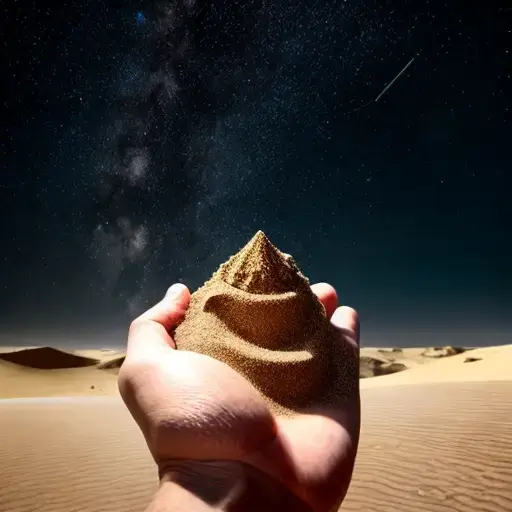How Many Atoms in a Grain of Sand? How about compared to Stars in the Universe and other things? Atoms are the building blocks of everything, but they're so small you can't see them. This leads to some mind bending claims, like:
There are more atoms in a grain of sand than stars in the universe.
Sounds wild, right? Let's check the numbers.
In the following post we will;
- 🔬 Count the atoms in a single grain of sand
- 🌌 Compare that to stars in the cosmos
- 🏖 Stack it up against Earth's sand and even your own body

Quick Answers
- One grain of sand (~0.1 mm) → ~41 quadrillion atoms (4.17 × 10¹⁶)
- Stars in the observable universe → ~10 sextillion (10²²)
- Grains of sand on Earth → ~7.5 quintillion (7.5 × 10¹⁸)
- Atoms in the human body → ~7 octillion (7 × 10²⁷)
How Many Atoms Are in a Grain of Sand?
Atoms are the tiny building blocks that make up everything around us. A single grain of sand contains an almost unimaginable number of these atoms. In this section, we'll break down how many atoms are packed into just one tiny grain, and why the number is so surprisingly large.
Step 1: What's Sand Made Of?
Most sand is quartz (silicon dioxide, SiO₂). Each SiO₂ molecule = 3 atoms (1 silicon + 2 oxygen).
Step 2: Grain vs Atom Size
A grain is ~0.1 mm across. A silicon atom is ~0.3 nanometers. That means a single grain is about 300, 000 times bigger than an atom.
Step 3: The Math (for the curious)
- Grain radius = 0.05 mm = 0.005 cm
- Volume = (4/3)πr³ ≈ 5.24 × 10⁻⁷ cm³
- Mass = volume × density (2.65 g/cm³) ≈ 1.39 × 10⁻⁶ g
- Moles = mass ÷ molecular weight (60.08 g/mol) ≈ 2.31 × 10⁻⁸ mol
- Molecules = moles × Avogadro's number ≈ 1.39 × 10¹⁶
- Total atoms = molecules × 3 = 4.17 × 10¹⁶ atoms
Imagine this: If each atom were the size of a grain of rice, they'd fill an Olympic swimming pool.
Sand vs Other Things
Things With More Atoms
- Sugar crystal → 10²³–10²⁴ atoms (100 sextillion – 1 septillion)
- Salt crystal → 10¹⁸–10²¹ atoms (quintillions – sextillions)
- Human body → ~7 × 10²⁷ atoms (7 octillion)
Things With Fewer Atoms
- Pollen grain → 10⁵–10⁶ atoms
- Dust particle → 10³–10⁶ atoms
- One DNA molecule → 10⁹–10¹⁰ atoms
Stars vs. Atoms in a Grain
NASA estimates ~10²² stars in the observable universe. Compare that to ~4.17 × 10¹⁶ atoms in one grain of sand:
There are ~240, 000× more stars than atoms in a single grain of sand.
Earth's Sand Supply vs a Single Grain
The University of Hawaii estimates ~7.5 × 10¹⁸ grains of sand on Earth. That's nearly 180, 000× more grains of sand than atoms in one grain.
Making Sense of Big Numbers
| Scale | Number | Power of 10 |
|---|---|---|
| Thousand | 1, 000 | 10³ |
| Million | 1, 000, 000 | 10⁶ |
| Billion | 1, 000, 000, 000 | 10⁹ |
| Trillion | 1, 000, 000, 000, 000 | 10¹² |
| Quadrillion | 1 followed by 15 zeros | 10¹⁵ |
| Quintillion | 1 followed by 18 zeros | 10¹⁸ |
| Sextillion | 1 followed by 21 zeros | 10²¹ |
| Octillion | 1 followed by 27 zeros | 10²⁷ |
Common Misconceptions
- ❌ More atoms in a grain than stars → False
- ✅ More grains on Earth than atoms in one grain → True
- ❌ All sand identical → False (different minerals, densities, and sizes)
FAQ
How many grains of sand are on Earth?
~7.5 quintillion (7.5 × 10¹⁸).
Are there more atoms in a grain than stars in the universe?
No. One grain has ~41 quadrillion atoms. The universe has ~10 sextillion stars.
How many atoms in one grain?
~4.17 × 10¹⁶ atoms.
What is a grain of sand made of?
Mostly silicon dioxide (SiO₂).
How does the human body compare?
It has ~7 octillion atoms, vastly more than a single grain.
Final Take on Atoms in a Grain of Sand
Atoms are unimaginably small, yet they build everything we see and are. Comparing them to stars and sand helps us glimpse both the microscopic and the cosmic.
If you enjoyed this, take a ride into the stars: constellation names and their meanings.